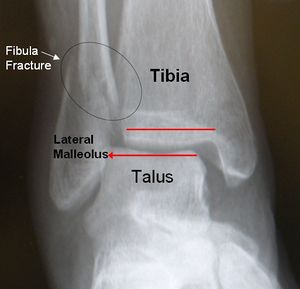Fibular fractures are usually the result of major trauma. They can be complete or incomplete fracture in the small bones that is located between the ankle and the knee. This type of fracture is common but the displacement of the bone does not always mean severe damage. It is possible that when there is severe ankle sprain, fibula fractures can also happen at the same time. Most prone to these types of injuries are older women who have fractures on their ankles, as well as athletes because of repetitive loading of weight to their body especially during strenuous training. Athletes engaged in sports that require the use of their legs can also be susceptible to it. Because of the triggers of fibular fractures, it has become otherwise known as stress fractures.
Types of Fibular Fractures
There are only two kinds of fractures that commonly occur to the fibular bone.
• Proximal fibular fractures. This is usually associated with the fractures of the tibia so it is considered an isolated fracture. It can be caused by direct or indirect forces but the usual cause of the fracture is due to the forced external rotation of the distal fibula which can damage the peroneal nerve and make the knee and ankle unstable.
• Stress fibular fractures. This is caused by the constant and prolonged application of force to the bones of the lower leg and most common on physically active young men and women. High impact running, marching, dancing and other sports that utilize the feet frequently can damage the fibula.
Diagnosis
If complete physical examination is done, it may reveal that there is tenderness, swelling, and palpitation of the fractured area therefore a neurovascular examination must also be done. If there is a blunt trauma, the tibia and the ankle must be included with the musculoskeletal examination. However, x-rays will confirm the real status of the fibula and if required, a CT scan or an MRI must also be conducted to assess completely if the fracture extends to the knee joint.
Causes
There can be many causes of fibular fractures but generally these are due to trauma. For women, the most common is the isolated fibular fracture which is accompanied by fractures in the ankles. With repetitive stress in the lower limbs, stress fractures usually result. Ankle sprains can also cause forced inversion of the foot to twist laterally and this can cause a fracture to the fibula. However, the major causes of fibular fractures are from major trauma and injuries from crashes wherein the neurovascular structures and the ligaments are also damaged.
Symptoms
Physically, we can see symptoms of fractured fibula by the following manifestations:
• There is a slight to very severe pain in the leg particularly behind the shin
• The calf is very tender to touch and there is swelling on the leg
• There could be bleeding and bruising on the area
• The person is unable to bear his own weight when standing upright
• There could be visible deformity if there is a complete separation of the fibula
• Numbness usually follows after the fibula fractures and the skin will feel cold especially if the supply of blood has been impaired already due to swelling.
Fibular Fracture Treatment
For the initial treatment, the injured person must raise his or her leg and put an ice pack to relieve the pain and reduce the swelling of the muscles. RICE principle will be followed so that swelling, inflammation and pain can be reduced. RICE stands for Rest, Ice, Compression, and Elevation. However, this is only for the initial procedure. The patients must still be brought to the hospital for complete bone checkup.
If there is an open fracture, this must undergo irrigation under pressure then there will be removal of dead tissue surgically. If an x-ray or bone scanning shows that there is a compound fracture that’s displacing the bones, this may require surgery and will undergo open reduction internal fixation. Pins, screws, plates, or rods will be positioned longitudinally to the bone shaft.
Prevention
There are actually no definite measures to prevent fibula fracture injury when it comes to actual physical activities. For football players, it is advisable that they must always wear thick shin guards all the time. For those who are always subjecting their legs under stress they must be cautious not to overdo leg training and must lower the strength and intensity they put on their legs. Running shoes must have shock-absorbing capacities to prevent damage to the calf area. For women, they should pay close attention to their diet and to have sufficient levels of calcium in their system since they are the ones who wear high heels that pose danger to their fibular bone.
When to Call A Doctor
By physical symptoms alone, you can already determine if you need to bring the injured person to the doctor. There could be swelling and discoloration of the calf that may turn red and then bluish and the skin may feel initially hot and then cold. If the skin also palpitates this may indicate that there is a broken bone within the tibia or the fibula. Severe pain is also another indicator that medical attention is needed.

Comments
Post a Comment
Please do not enter any spam link in the comment box.